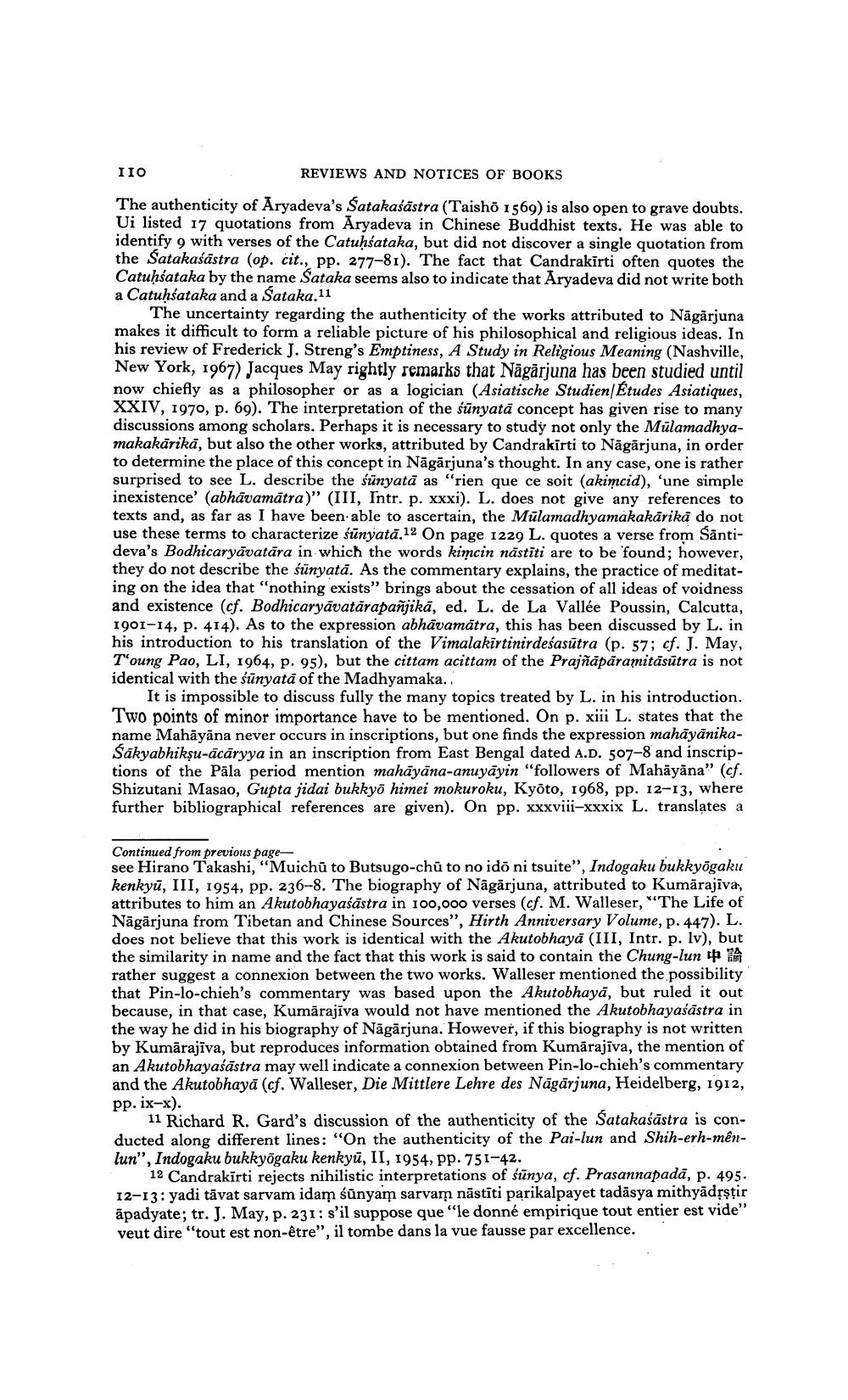________________
REVIEWS AND NOTICES OF BOOKS
The authenticity of Aryadeva's Satakaśāstra (Taisho 1569) is also open to grave doubts. Ui listed 17 quotations from Aryadeva in Chinese Buddhist texts. He was able to identify 9 with verses of the Catuḥsataka, but did not discover a single quotation from the Satakaśāstra (op. cit., pp. 277-81). The fact that Candrakirti often quotes the Catuḥśataka by the name Sataka seems also to indicate that Aryadeva did not write both a Catuḥsataka and a Sataka. 11
The uncertainty regarding the authenticity of the works attributed to Nāgārjuna makes it difficult to form a reliable picture of his philosophical and religious ideas. In his review of Frederick J. Streng's Emptiness, A Study in Religious Meaning (Nashville, New York, 1967) Jacques May rightly remarks that Nägarjuna has been studied until now chiefly as a philosopher or as a logician (Asiatische Studien Études Asiatiques, XXIV, 1970, p. 69). The interpretation of the sūnyată concept has given rise to many discussions among scholars. Perhaps it is necessary to study not only the Mülamadhyamakakārikā, but also the other works, attributed by Candrakirti to Nāgārjuna, in order to determine the place of this concept in Nāgārjuna's thought. In any case, one is rather surprised to see L. describe the sünyatā as "rien que ce soit (akimcid), 'une simple inexistence' (abhāvamātra)" (III, Intr. p. xxxi). L. does not give any references to texts and, as far as I have been able to ascertain, the Mülamadhyamakakārikā do not use these terms to characterize śünyatā.12 On page 1229 L. quotes a verse from Santideva's Bodhicaryāvatāra in which the words kimcin nāstīti are to be found; however, they do not describe the sünyatā. As the commentary explains, the practice of meditating on the idea that "nothing exists” brings about the cessation of all ideas of voidness and existence (cf. Bodhicaryāvatārapañjikā, ed. L. de La Vallée Poussin, Calcutta, 1901-14, p. 414). As to the expression abhāvamätra, this has been discussed by L. in his introduction to his translation of the Vimalakirtinirdeśasūtra (p. 57; cf. J. May, T'oung Pao, LI, 1964, p. 95), but the cittam acittam of the Prajñāpāramitāsūtra is not identical with the sūnyatā of the Madhyamaka.
It is impossible to discuss fully the many topics treated by L. in his introduction. Two points of minor importance have to be mentioned. On p. xiii L. states that the name Mahāyāna never occurs in inscriptions, but one finds the expression mahāyānikaSākyabhikṣu-ācāryya in an inscription from East Bengal dated A.D. 507-8 and inscriptions of the Pāla period mention mahāyāna-anuyāyin "followers of Mahāyāna" (cf. Shizutani Masao, Gupta jidai bukkyā himei mokuroku, Kyoto, 1968, pp. 12-13, where further bibliographical references are given). On pp. xxxviii-xxxix L. translates a
Continued from previous pagesee Hirano Takashi, "Muichū to Butsugo-chū to no ido ni tsuite", Indogaku bukkyōgaku kenkyū, III, 1954, pp. 236-8. The biography of Nāgārjuna, attributed to Kumārajīva, attributes to him an Akutobhayaśāstra in 100,000 verses (cf. M. Walleser, "The Life of Nāgārjuna from Tibetan and Chinese Sources", Hirth Anniversary Volume, p. 447). L. does not believe that this work is identical with the Akutobhayā (III, Intr. p. lv), but the similarity in name and the fact that this work is said to contain the Chung-lun rather suggest a connexion between the two works. Walleser mentioned the possibility that Pin-lo-chieh's commentary was based upon the Akutobhayā, but ruled it out because, in that case, Kumārajīva would not have mentioned the Akutobhayaśāstra in the way he did in his biography of Nāgārjuna. However, if this biography is not written by Kumārajīva, but reproduces information obtained from Kumārajīva, the mention of an Akutobhayaśāstra may well indicate a connexion between Pin-lo-chieh's commentary and the Akutobhayā (cf. Walleser, Die Mittlere Lehre des Nāgārjuna, Heidelberg, 1912, pp. ix-x).
11 Richard R. Gard's discussion of the authenticity of the Satakaśāstra is conducted along different lines: “On the authenticity of the Pai-lun and Shih-erh-mênlun", Indogaku bukkyōgaku kenkyū, II, 1954, pp. 751-42.
12 Candrakīrti rejects nihilistic interpretations of sūnya, cf. Prasannapadā, p. 495. 12-13: yadi tāvat sarvam idam śünyam sarvam nāstīti parikalpayet tadāsya mithyādņştir āpadyate; tr. J. May, p. 231: s'il suppose que "le donné empirique tout entier est vide" veut dire "tout est non-être", il tombe dans la vue fausse par excellence.




